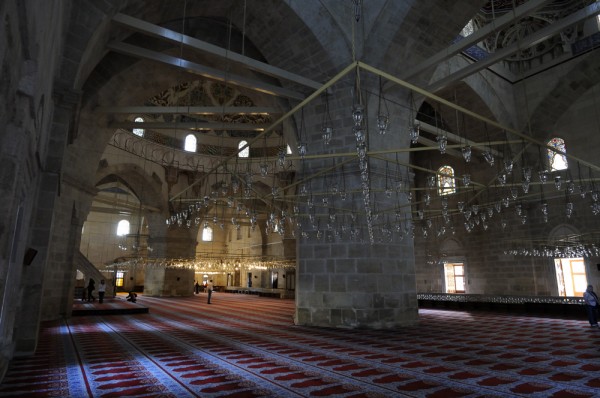Edirne is one of the former capital cities of Ottoman empire. However it is better known with the Selimiye mosque.
Selimiye Mosque gallery link is here.
In case you are interested in other photos from Edirne, then you may follow this link as well.
A general inner view is given below together with information taken from Wikipedia.

From Wikipedia:
The Selimiye Mosque (Turkish: Selimiye Camii) is an Ottoman mosque in the city of Edirne, Turkey. The mosque was commissioned by Sultan Selim II and was built by architect Mimar Sinan between 1568 and 1574. It was considered by Sinan to be his masterpiece and is one of the highest achievements of Islamic architecture.
This grand mosque stands at the center of a k?lliye (complex of a hospital, school, library and/or baths around a mosque) which comprises a medrese (Islamic academy teaches both Islamic and scientific lessons), a dar-?l hadis (Al-Hadith school), a timekeeper’s room and an arasta (row of shops). In this mosque Sinan employed an octagonal supporting system that is created through eight pillars incised in a square shell of walls. The four semi domes at the corners of the square behind the arches that spring from the pillars, are intermediary sections between the huge encompassing dome (31.25m diameter with spherical profile) and the walls.
While conventional mosques were limited by a segmented interior, Sinan’s effort at Edirne was a structure that made it possible to see the mihrab from any location within the mosque. Surrounded by four tall minarets, the Mosque of Selim II has a grand dome atop it. Around the rest of the mosque were many additions: libraries, schools, hospices, baths, soup kitchens for the poor, markets, hospitals, and a cemetery. These annexes were aligned axially and grouped, if possible. In front of the mosque sits a rectangular court with an area equal to that of the mosque. The innovation however, comes not in the size of the building, but from the organization of its interior. The mihrab is pushed back into an apse-like alcove with a space with enough depth to allow for window illumination from three sides. This has the effect of making the tile panels of its lower walls sparkle with natural light. The amalgamation of the main hall forms a fused octagon with the dome-covered square. Formed by eight massive dome supports, the octagon is pierced by four half dome covered corners of the square. The beauty resulting from the conformity of geometric shapes engulfed in each other was the culmination of Sinan’s life long search for a unified interior space.


